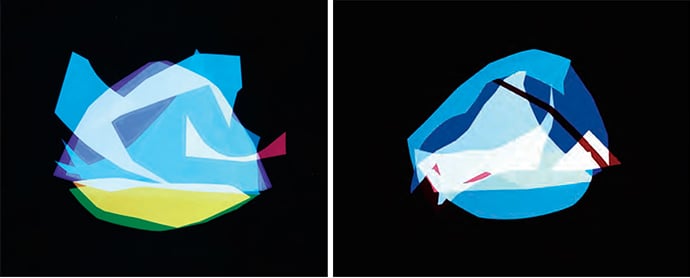
“Birdhouse” and “Winter Vacation,” analog chromogenic photograms by Liz Nielsen © The artist. Courtesy Black Box Projects, London
Rising temperatures will make Muslims’ pilgrimages to Mecca increasingly dangerous, will cause Appalachian salamanders to use their regenerating ability as a heat buffer, will hurt New Hampshire salamanders by decreasing streamflow consistency, will kill most loggerhead turtle broods in the Cape Verde Islands before they hatch and make the hatchlings who survive almost entirely female, and will cause Brazilian loggerheads to flourish for a few generations and then begin to die off. Warming was already making lakes hotter at the top and colder at the bottom. A global media survey found that the news in rich countries tends to politicize climate change, while the news in poor countries treats it as an apolitical international problem; a new study, contradicting earlier findings, predicted that all countries, whether rich or poor, hot or cold, will be substantially harmed by global warming; and a group of scientists recommended, in lieu of a panicked response to future disasters, the orderly withdrawal of at-risk coastal populations. Icelanders held a funeral ceremony for the Okjökull glacier. “We know what is happening and what needs to be done,” read a memorial plaque placed at the site for humans of the future. “Only you know if we
did it.” Plastic snow was falling on the Arctic.
The ecological impact of food waste was found to be less than that of overeating. Methane spikes in Los Angeles were linked to seasonal home heating, and methane spikes in the global atmosphere were linked to fracking. Special-education enrollment in Flint, Michigan, has increased by more than 50 percent since the onset of the city’s water crisis. The Centers for Disease Control, responding to Salmonella outbreaks, warned Americans against kissing and snuggling their chickens. Red deep-sea crabs were being lured to mate by scents emanating from the Deepwater Horizon spill, where they were turning black and sluggish and undergoing mutations. In a Texas lake, an alligator was observed basking with a knife in its head. DNA in the waters of Loch Ness suggested that the Monster may be a giant eel. Electrophorus voltai, a new species discovered in the Amazon Basin, was found to generate shocks of 860 volts, making it the most electric of all eels. Captive breeding was proving unable to offset the decline in the wild Japanese glass eel population. A diet of raw fish, frogs, and mollusks was suggested by the Bronze Age feces of the fen folk of Must Farm.
New rock cores from the Campeche Bank allowed scientists to construct a timeline of the twenty-four hours after the Chicxulub Impact, and supported the theory that the massive global cooling that followed was caused by the vaporization of sulfur at the impact site. Scientists identified an additional mass extinction at the end of the Guadalupian Period, likely caused by the Emeishan flood-basalt eruption, and making the current mass extinction the earth’s seventh. Climate change was exposing lost wrecks and ruins. Humans on the Pannonian Plain during the fifth and sixth centuries b.c. deliberately deformed their skulls, which, researchers assume, allowed them to more clearly identify as members of certain cultural groups. Archaeologists excavating the ruins of Pompeii, where recent discoveries include a skeleton crushed by a massive stone block and clutching twenty silver and two bronze coins to its chest, unveiled a trove of beads and figurines. Made of amethyst, bone, faience, glass, turquoise, and umber, and including phallic amulets, scarabs, a woman, a dancing satyr, and a head of Dionysus, they are thought to be the treasure box of a sorceress. On the moon, in the Sea of Serenity, water bears that were traveling on Israel’s Beresheet spacecraft when it crashed in April are assumed to be alive, and on the dark side, China’s Jade Rabbit discovered an unidentified substance with a “mysterious luster.”






































































































